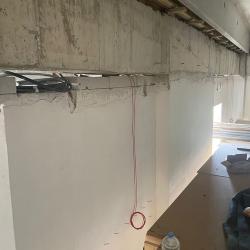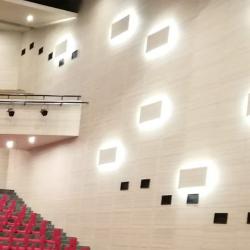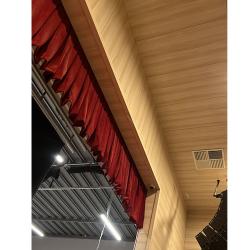Stage curtains
What Is a Stage Curtain and Why Does It Matter?
Installing a curtain on a stage isn’t just a decorative move; it’s a critical element for managing audience attention, concealing backstage preparation, and ensuring the event flows professionally. Through years in this business, I’ve learned one thing clearly: no matter how good your lighting is, if the right stage curtain isn’t in place, the venue won’t feel complete.
Last month, we worked on a cultural center in Istanbul. Their existing curtains were made of very thin fabric, allowing all the backstage preparation to be visible through backlighting. Audience members were uncomfortable, and the venue management was constantly receiving complaints.
We stepped in and proposed a new light-blocking, velvet-textured, flame-retardant certified curtain. We designed a triple-layer fabric system: main curtain, mid-stage divider, and rear backdrop. The result wasn't just improved aesthetics—it elevated the professionalism of the entire stage. After the first show, the venue director called and said, “We’ve used this stage for years, but this is the first time it looked this polished and high-end.”
Fabric Quality and Light Blocking
A stage curtain is the invisible line between the audience and the performance. If that boundary is weak, the magic is lost. Fabric quality plays a major role here. Clients often ask, “Isn’t any thick fabric okay?” My answer is always no. One of the biggest mistakes is confusing a window curtain with a stage curtain.
Take the example of a private school we worked with last year. They had purchased a heavy curtain from a local store. Within three months, it was shedding fibers and glowing under the spotlight, exposing backstage scenes. Every pull would release more lint.
We designed a curtain made from 100% cotton, 600 g/m² weight, with a black-out lining. Triple-stitched edges, pleated tops, and a bottom weight bar made it 100% light-blocking. When drawn, the stage is in complete darkness—perfect for dramatic transitions and lighting effects.
More than light-blocking, fabric safety matters. Curtains without flame-retardant certification can cause licensing issues. All our fabrics meet EU fire safety standards with verified certification. Your opening night happens with peace of mind.
Track System and Open-Close Mechanisms
A curtain’s material is important, but how it opens and closes is just as critical. A good system should be quiet, smooth, and durable. Let me give you a real example.
Last year, we replaced an old track system at a university auditorium. The previous curtain was getting stuck and making loud noises during use. The ambiance was being ruined before the speech even began.
We installed curved aluminum rails with Teflon-coated runners. The movement became virtually silent. The system was motorized with remote control. For smaller venues, we also offer manual rope systems, but for large halls, I always recommend motorized ones—no one wants a staff member awkwardly pulling ropes mid-show.
Our track systems are modular. If you want to change the curtain later, you don’t need to dismantle the entire rail. These small details make a big difference over time.
Color and Aesthetic Harmony
Many people see the curtain as just a necessity, but we know that visual harmony in a hall depends on the smallest details. Color is one of those key details.
Last month, we were asked to install a red stage curtain in a cultural center. But the chairs were blue and the walls beige. The red clashed terribly. We intervened, took color samples from the chairs and walls, and had a custom velvet fabric made in a deep burgundy tone. The result? A much warmer, more refined atmosphere. We used a matte texture to avoid reflective glare under the lights.
Before finalizing production, we bring sample fabrics and test them under your venue’s actual lighting. Showroom lights lie—real decisions happen on-site. We also offer custom-printed, embroidered, or patterned curtains. The key is finding a color that reflects the character of your venue.
Multi-Functional Use and Intermediate Curtains
Modern halls aren’t used only for conferences. Theater, presentations, live music, movie screenings—all demand different curtain setups. That’s why intermediate curtain systems are becoming increasingly popular.
Three months ago, we installed a stage curtain for a private school that requested a dual-layer setup: a main curtain and a mid-stage divider to conceal set changes. We added a second rail line behind the primary track and used a sheer black drape as the inner curtain. This allowed the crew to prep silently while another act was wrapping up.
We also installed two side curtains to minimize peripheral lighting. Audience focus remained centered on the stage. If your venue is multi-purpose, don’t settle for a single-layer curtain. Think layered, think functional. We have ready-made solutions for such cases.
Installation and Handover Process
You’ve picked the perfect curtain—great material, solid track, ideal color. But if the installation isn’t precise, you’ll have issues within the first week. We treat the installation process as seriously as fabric selection.
We begin by taking precise measurements using laser devices—no guesses. We assess rail length, stage height, and depth. Curtain production takes 5–10 days, including fabric sewing and track preparation.
On installation day, our team arrives early. By the end of the same day, everything is set up. We test the movement, check for noise, ensure proper spacing above the floor. After a thorough cleanup, we hand over the hall—ready to use.
And we don’t disappear afterward. If the curtain malfunctions or needs adjustment, our technical team is one call away. We stay responsible long after the sale.
Our company, starting with the production of conference chairs and conference chair manufacturing, now also undertakes turnkey project planning, including conference hall construction.
Our journey, which began with conference chair manufacturing, has evolved with the experience gained over time. Continuing our services with furniture, stage curtains, and acoustic sound systems for conference halls, we now deliver your projects smoothly and in the shortest time with turnkey conference hall construction.
The conference hall chairs on our page are prepared according to the project or customer requirements. Since the products are specially made for an individual or venue, it is very difficult to use them in another venue, so returns are not possible for conference chairs.
As Bereket Office, spare parts for the conference chairs we manufacture are always available. In addition to plastic covers, conference chair spare parts for other companies are also available. The delivery time for spare parts may vary depending on the model and the requested quantity.
The production of conference chairs varies depending on the order quantity, the ordered model, and the workload at the time of the order. However, the average production time is 10 days.
The conference chairs, conference seats, and project-based products manufactured and listed on our page are guaranteed by our company for 2 years.
Since we do not keep conference chairs in stock and produce them upon order, they are manufactured in the colors and features you request.
We provide assembly services for a fee for the conference chairs we manufacture. Depending on workload, we also offer assembly services for products purchased from other companies.
Our conference chairs are offered in different sizes depending on the model. Generally, the seat width ranges from 45-55 cm, and the backrest height varies between 50-70 cm. For detailed measurements, you can contact our company for more information.
Depending on the process to be performed and the number of chairs, conference chair repair for existing conference chairs in conference halls is carried out by our company.
Our chairs are manufactured with high-quality fabric, leather, or synthetic leather upholstery. Durable metal or wooden materials are used for the frame. The foam filling is designed with high density for long-term comfort.
Fabric-upholstered chairs can be cleaned with a damp cloth and mild detergent. For leather or synthetic leather upholstery, special leather cleaners are recommended. Avoid abrasive chemicals.


